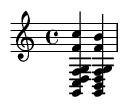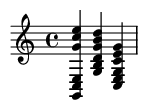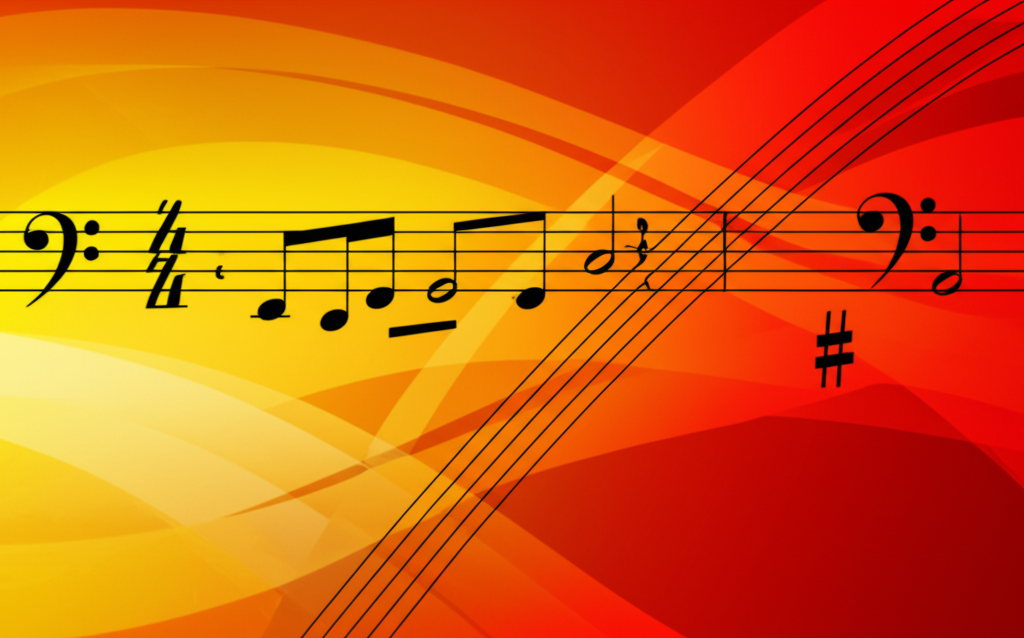Summary:
The sus4 chord (suspended fourth) is a triad where the third is replaced by a perfect fourth above the root. This creates a distinctive, open-sounding harmony with a strong tendency to resolve. The tension arises primarily from the fourth's pull towards the third, making it one of the most recognizable and emotionally powerful tools in both classical and popular music.
Keywords:
Sus4 chord, suspended fourth, suspension, resolution, tension, harmony, music theory, voice leading, dissonance, cadential 6/4, guitar chords, piano chords.
Introduction:
The sus4 chord stands as one of music's most fundamental harmonic devices. By replacing a chord's third with the fourth scale degree, it creates a moment of harmonic tension that begs for release. This simple substitution generates a powerful sense of anticipation, making the sus4 chord an essential tool for building musical drama and emotional depth.
Rooted in the strict voice-leading rules of classical counterpoint, the sus4 has evolved to become a staple in nearly every genre. Its distinctive sound—neither major nor minor, but uniquely poised and unresolved—has made it a cornerstone of everything from Bach chorales and rock anthems to jazz improvisations and film scores.
Structure and Construction:
A sus4 chord is built using the following intervals from the root:
- Root: The foundational note of the chord.
- Perfect Fourth: The note 5 semitones above the root. This replaces the third.
- Perfect Fifth: The note 7 semitones above the root.
Interval Structure:
A sus4 chord is formed by stacking a Perfect Fourth and a Major Second.
Root to fourth: 5 semitones
Fourth to fifth: 2 semitones
Total span (Root to fifth): 7 semitones (Perfect Fifth)
Musical Examples:
C sus4 Chord:
The basic C sus4 chord consists of the notes C, F, and G.
Typical Sus4 Resolution (to Major and Minor) :
The most common function of a sus4 chord is to resolve. The suspended 4th moves down by a half step to the major 3rd or a whole step to the minor 3rd. Here, Gsus4 resolves first to G major, then Gm.

Harmonic Character:
The unique sound of the sus4 chord comes from these qualities:
- Anticipation and Tension: The primary source of tension is the suspended 4th, which creates a strong melodic pull down to the 3rd.
- Ambiguous Tonality: Lacking a 3rd, the chord is neither major nor minor, giving it an open, floating quality.
- Dramatic Effect: By delaying the arrival of the 3rd, a sus4 chord can heighten the emotional impact of a resolution.
- Smooth Voice Leading: The stepwise motion from 4 to 3 provides a seamless and satisfying melodic connection between chords.
Classical Origins vs. Modern Usage:
It's crucial to distinguish between the historical and contemporary uses of the sus4 sound.
- Classical Suspension: In traditional counterpoint, a suspension is a melodic event, not a chord. A note from a previous chord (the preparation) is held over (the suspension) into a new chord where it is dissonant, and then resolves downwards (the resolution). The "4-3 suspension" is the origin of the modern sus4 sound.
- Modern Sus Chord: In pop, rock, and jazz, the sus4 is often treated as a standalone chord. It doesn't require preparation and may never resolve, functioning as a color chord in its own right.
Classical 4-3 Suspension Example:
In the key of C, a Gsus4 (the dominant sus) resolves to G (the dominant) before landing on C (the tonic). Notice how the C in the Gsus4 chord is held over from the previous C chord (implied preparation) before resolving to B.

Popular Music Applications:
The sus4 chord is a defining sound in modern music:
- Rock Music: Creates powerful, anthemic riffs and soaring choruses (e.g., The Who, Tom Petty) .
- Folk and Acoustic: The open sound complements acoustic instruments and fingerpicking styles (e.g., Simon & Garfunkel, Kansas).
- Pop Ballads: Used to build emotional weight in pre-choruses and bridges, resolving at the climax.
- Jazz: Often extended (e.g., 7sus4, 9sus4) and used as a substitute for dominant chords, especially in modal jazz.
Famous Musical Examples:
Listen for the distinctive sus4 sound in these iconic tracks:
- "Free Fallin'" by Tom Petty: The main riff cycles through F - Fsus4 - F - Csus4.
- "Pinball Wizard" by The Who: Built around a powerful Bsus4 - B riff.
- "A Hard Day's Night" by The Beatles: The famous opening chord is a complex G7sus4.
- "Crazy Little Thing Called Love" by Queen: Uses Dsus4 to D in its rockabilly progression.
- "Dust in the Wind" by Kansas: The fingerpicked intro is built on Asus2 - Asus4 - G - C progressions.
Guitar Techniques:
The guitar is exceptionally well-suited for sus4 chords, often requiring minimal finger movement to create the suspension and resolution.
- Open Chord Embellishments: Easily add a finger to an open chord shape (like D to Dsus4, or A to Asus4) to create movement.
- Hammer-ons and Pull-offs: Use these techniques to melodically articulate the 4-3 resolution.
- Power Chord Extensions: Adding a 4th to a power chord creates a thick, modern rock sound.
Common Guitar Sus4 Voicings:
Dsus4: xx0233 (resolves to D: xx0232)
Asus4: x02230 (resolves to A: x02220)
Gsus4: 3x0013 (resolves to G: 320003)
Esus4: 022200 (resolves to E: 022100)
Piano Approaches:
On piano, sus4 chords offer rich voicings and harmonic possibilities:
- Block Chords: Playing the full triad (Root-4th-5th) creates a strong, clear statement.
- Arpeggiation: Breaking the chord into individual notes highlights its open quality.
- Pedal Point: Holding the root and fifth in the left hand while alternating between the 4th and 3rd in the right hand is a classic compositional technique.
Extended Sus4 Harmonies (Jazz):
In jazz, sus4 chords are frequently extended with 7ths, 9ths, and 13ths. The 7sus4 chord is particularly common, often functioning as a substitute for a V7 chord.
- C7sus4: C - F - G - Bb
- C9sus4: C - F - G - Bb - D
Jazz 7sus4 Resolution:
A common ii-V-I progression might use a V7sus4 chord to delay the V7. Here is G7sus4 resolving to G7.

The Cadential 6/4 Chord:
A very specific and important use of the sus4 sound in classical music is the Cadential 6/4. This isn't a true sus4 chord but functions identically. It is a Tonic chord in second inversion (notated I6/4) placed before the Dominant chord in a cadence. The root and third of the tonic chord (e.g., C and E in the key of C) act as a double suspension over the dominant's root (G), creating the sound of a Gsus4 before resolving to the V chord.
Cadential 6/4 Example (I6/4 - V - I):
In C Major: C/G (I6/4) resolves to G (V), which then resolves to C (I).

Common Progressions:
Sus4 chords appear in countless progressions. Here are a few archetypes:
- Isus4 - I: The simplest form of resolution, decorating the tonic chord.
- Vsus4 - V - I: The classic dominant suspension leading to a perfect cadence.
- IV - Vsus4 - I: A strong progression where the root of the IV chord becomes the suspended 4th of the V chord.
- Am - G - C - F (using sus) : A modern pop progression might feature Dsus4 - D instead of G, or Asus4 - A.
Common Mistakes:
- Ignoring Context: Using a strict classical resolution in a rock song can sound stiff. Conversely, using an unresolved sus4 chord in a traditional chorale can sound incorrect.
- Forgetting the Resolution (in traditional styles): The power of the sus4 in classical and jazz often comes from its resolution. Leaving it hanging can feel unsatisfying if the style demands closure.
- Poor Voice Leading: In any style, ensure the movement from the 4th to the 3rd is smooth and intentional. Awkward leaps can undermine the chord's effect.
Fun Facts:
- The term "suspension" comes from the Latin "suspendere," meaning "to hang," describing how one note is "left hanging" from a previous chord.
- In jazz shorthand, a sus4 chord is sometimes written as "11" (e.g., G11) with the understanding that the 3rd is omitted.
- The chords Gsus4 (G-C-D) and Csus2 (C-D-G) contain the same notes. Gsus4 is a G chord with a suspension, while Csus2 is a C chord with a suspension. Context and bass note determine the name and function.
Conclusions:
The sus4 chord is a testament to the power of tension and release in music. From its disciplined origins in contrapuntal voice leading to its free-spirited use in modern rock and pop, it has proven to be an incredibly versatile and expressive harmonic tool.
Understanding the structure, function, and feel of the sus4 chord opens up a world of compositional and performance possibilities. It allows you to add emotional weight, create smooth transitions, and build anticipation in your music. Whether you are composing a string quartet or a rock anthem, mastering the art of the suspended fourth will undoubtedly elevate your harmonic vocabulary and connect you to a tradition spanning centuries of musical expression.
